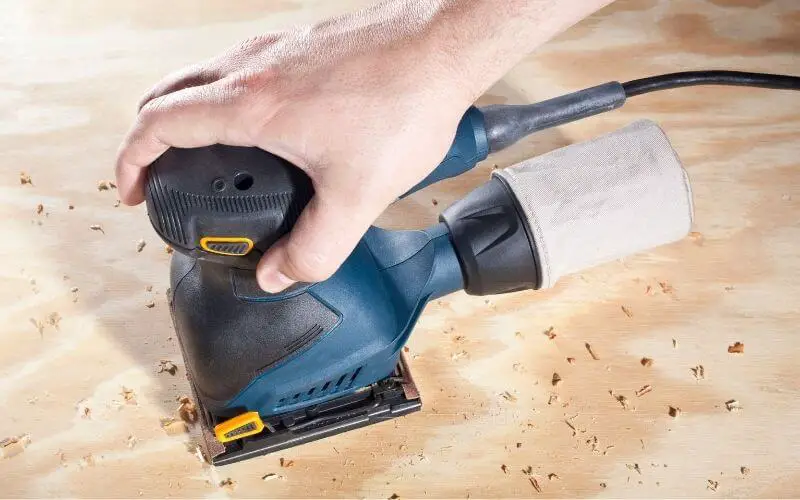Remember that time you decided to tackle a home improvement project, thinking it would be a quick and easy fix? You envisioned yourself effortlessly sanding your hardwood floors, achieving a gleaming, revitalized finish. But then reality set in. The sheer size of your project, the daunting task of handling heavy equipment, and the potential for disastrous mistakes began to overwhelm you. That’s where the question arises: can I actually sand my hardwood floors with a hand sander?

Image: carpet.vidalondon.net
The answer, as with most things in life, is complex. While using a hand sander might seem like a good idea for smaller areas or those difficult-to-reach corners, there are many factors to consider. This article will delve into the intricacies of sanding hardwood floors with a hand sander, exploring the pros, cons, and everything in between. So buckle up, grab your sander, and let’s get to sanding!
Understanding the Pros and Cons of Hand Sanders
Hand sanders, despite their smaller size and seemingly less intimidating presence, can be powerful tools. They offer a level of control that larger, more powerful sanders might lack. However, this control comes at a price. Hand sanders require more effort and time to achieve the same results as their larger counterparts, making them less suitable for large or extensive projects.
Let’s break down the pros and cons to help you make an informed choice:
Pros:
- Control and Precision: Hand sanders offer greater maneuverability and precision, allowing you to tackle intricate areas like corners and edges with ease.
- Smaller Footprint: Their compact size makes them ideal for smaller projects like sanding specific areas or repairing minor damage.
- Lightweight and Portable: Hand sanders are generally lighter and more portable than their larger counterparts, allowing for easier transport and storage.
Cons:
- Time-Consuming: Hand sanding requires more time and effort to achieve the same results as larger sanders.
- Physical Strain: The repetitive motions of hand sanding can cause physical strain and fatigue.
- Uneven Results: Achieving a perfectly even finish with a hand sander can be challenging, potentially resulting in uneven sanding patterns.
- Dust Generation: Hand sanding generates considerable dust, requiring proper safety precautions like masks and dust collection systems.

Image: floorcarekits.com
When is a Hand Sander Appropriate for Hardwood Floor Sanding?
While a hand sander might not be the ideal tool for sanding entire floors, it can be a valuable asset for specific situations:
- Small Areas: Hand sanders are perfect for sanding small areas, like a hallway, a closet, or a few boards around the perimeter of a room.
- Patching and Repair: When sanding a small area to repair damage or blend in a patch, a hand sander provides the necessary control and precision.
- Corners and Edges: Reaching tight corners and edges with a large sander can be tricky. Hand sanders excel in these hard-to-reach spots, giving you the flexibility to work around obstacles.
- Hard-to-Reach Areas: Underneath furniture or cabinets, hand sanders offer maneuverability, allowing you to sand areas inaccessible to larger sanders.
Tips and Expert Advice for Using a Hand Sander
Successfully using a hand sander for hardwood floor sanding requires more than just plugging it in and sanding away. It demands patience, technique, and attention to detail. Here are some essential tips and expert advice:
- Choose the Right Grit: Start with a coarser grit sandpaper (like 40 or 60 grit) for removing old finishes and leveling the floor. Progress to finer grits (like 80 or 120) for smoothing and enhancing the floor’s finish.
- Overlap Your Strokes: Overlapping each sanding stroke by about 50% ensures even sanding and prevents uneven patterns.
- Maintain Even Pressure: Applying too much pressure can lead to uneven sanding and gouges in the wood. Maintain a consistent, light pressure during sanding.
- Work with The Grain: Always sand in the direction of the wood grain for a smooth, even finish. Sanding against the grain can create scratches and damage the wood.
- Clean Up Regularly: Throughout the sanding process, regularly clean the sander’s dust collection bag or vacuum up any debris to prevent clogging and improve dust control.
- Utilize Dust Collection: Invest in a dust collection system to minimize dust exposure. This can be a dust mask, a dust extractor, or a shop vacuum with a dust collection attachment.
FAQs about Hand Sander Hardwood Floor Sanding
Q. Can I sand hardwood floors with a hand sander if they are heavily damaged?
While a hand sander can be used for light sanding and repairs, it’s not recommended for heavily damaged floors. For these scenarios, a drum sander or an orbital sander is more effective.
Q. How do I choose the best sandpaper grit for hand sanding my hardwood floors?
Start with a coarser grit (40-60 grit) to remove old finish and level the floor. Gradually progress to finer grits (80-120 grit) for smoothing and finishing. Always sand with the grain for best results.
Q. What kind of hand sander is best for sanding hardwood floors?
For sanding hardwood floors, a random orbital sander is generally the best choice. It offers smooth, even sanding and reduces the risk of creating swirl marks.
Q. What are some safety precautions to take when sanding hardwood floors with a hand sander?
Wear safety glasses to protect your eyes from flying debris. Wear a dust mask or respirator to minimize dust inhalation. Ensure proper ventilation in the workspace. Use a dust collection system to remove dust.
Can I Sand My Hardwood Floors With A Hand Sander
Conclusion:
Sanding your hardwood floors with a hand sander can be a rewarding experience, offering control and precision, especially for smaller projects or repairs. However, it’s essential to understand the limitations and invest in a random orbital sander for optimal results. Remember, safety is paramount, and utilizing proper techniques and tools are vital for a successful project.
Are you considering using a hand sander on your hardwood floors? Share your thoughts and experiences in the comments below!



/GettyImages-173599369-58ad68f83df78c345b829dfc.jpg?w=740&resize=740,414&ssl=1)


